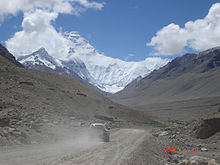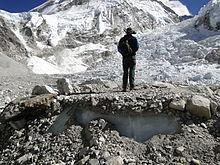- Everest Base Camp
-
There are two base camps on opposite sides of Mount Everest. South Base Camp is in Nepal at an altitude of 5,364 metres (17,598 ft) (28°0′26″N 86°51′34″E / 28.00722°N 86.85944°E), and North Base Camp is in Tibet at 5,545 metres (18,192 ft) 28°8′29″N 86°51′5″E / 28.14139°N 86.85139°E). These camps are rudimentary campsites on Mount Everest that are used by mountain climbers during their ascent and descent. South Base Camp is used when climbing via the southeast ridge, while North Base Camp is used when climbing via the northeast ridge.
Supplies are carried to the South Base Camp by sherpas or porters, and with help of animals, usually yaks. The North Base Camp has vehicle access (at least in the summer months). Climbers typically rest at base camp for several days for acclimatization; to reduce the risks and severity of altitude sickness.
Contents
South Base Camp
The Everest Base Camp trek on the south side is one of the most popular trekking routes in the Himalayas and is visited by thousands of trekkers each year. Trekkers usually fly from Kathmandu to Lukla to save time and energy before beginning the morning trek to this base camp. From Lukla, climbers trek upward to the Sherpa capital of [[Namche Bazaar]], 3,440 metres (11,290 ft), following the valley of the Dudh Kosi river. The village is a central hub of the area, and food, sundries and even mountain climbing equipment may be purchased here.
This takes about two days. Typically at this point, climbers allow a day of rest for acclimatization. They then trek another two days to Dingboche, 4,260 metres (13,980 ft) before resting for another day for further acclimatization. Another two days takes them to Everest Base Camp via Gorakshep, the flat field below [[Kala Patthar]], 5,545 metres (18,192 ft) and Mt. [[Pumori]].
North Base Camp
As of 2010, a visit to the North (Tibet-side) Base Camp required a permit from the Chinese government, on top of the permit required to visit Tibet itself. At this time such permits could be arranged relatively easily via travel companies in Lhasa, typically as part of a travel package that included hiring a vehicle, driver, and translator. Road access to the North Base Camp may be obtained from a road branching to the South from the Friendship Highway.
Gallery
-
A view of Everest North (Tibet-side) Base Camp looking west, August 3, 2002. The permanent structure at left is for mountain climbers, central-left structure is for pit toilets, while the temporary wood-frame, plastic tarpaulin-covered structures below and right are for other visitors and support people
See also
Categories:
Wikimedia Foundation. 2010.








